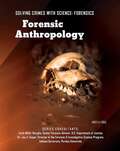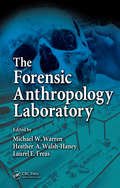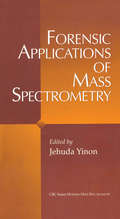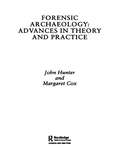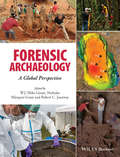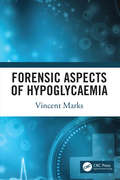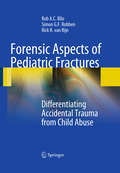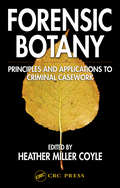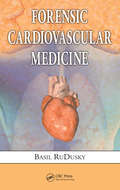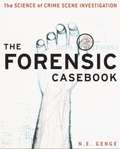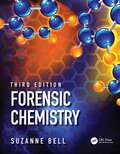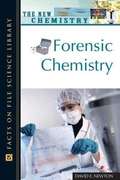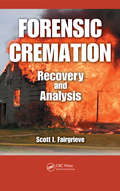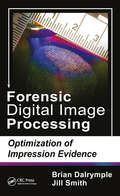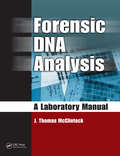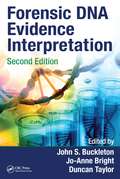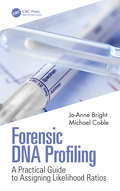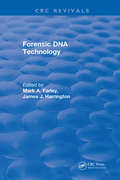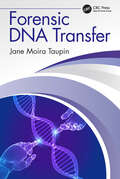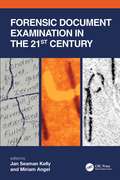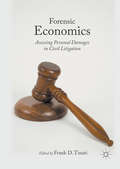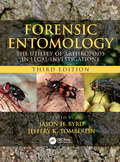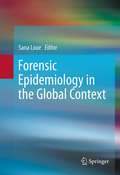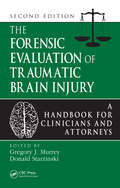- Table View
- List View
Forensic Anthropology (Solving Crimes With Science: Forensics)
by Angela LibalWelcome to the exciting world of forensic investigation--the science of solving crimes. This introduces the field of forensic anthropology, where scientists and criminal investigators use the human skeleton to solve some of the world's most mysterious and violent crimes. From the nineteenth-century murderer who boiled his wife in a vat of acid, to the modern-day pig farmer accused of murdering more than sixty women, forensic anthropology shows how even the tiniest fragments of bones can reveal the identities of victims as well as killers. From mass-transit accidents to war to genocide and terrorist attacks, this science also pieces together the most scattered and seemingly unidentifiable remains. Using recent finds such as bags of bones in the woods, or the five-thousand-year-old skeleton of a victim of foul play, forensic detectives use the smallest clues, revealing a massive crime-recording device: the human body. See how the dead do tell tales to those who know how to listen!
The Forensic Anthropology Laboratory
by Michael W. Warren Heather A. Walsh-Haney Laurel E. FreasWhile other books cover general topics and various subsets of forensic anthropology, this one-of-a-kind reference compiles the best practices of policies, procedures, and protocols of different laboratories across the world. This book brings together experts in every aspect of forensic anthropology to consider physical plant demands, equipment needs, staffing, ethical issues, and the process of certification with the American Society of Crime Laboratory Directors. With examples of implementation, The Forensic Anthropology Laboratory also provides discussion of proven methods in skeletal preparation, laboratory flow, and specimen curation including processing logs and sample forms.
Forensic Applications of Mass Spectrometry
by Jehuda Yinon Werner A. Baumgartner Wolfgang Bertsch Jean Louis Brazier Chen-Chih Cheng Bongchul Chung John T. Cody Thomas D. Donahue Dean D. Fetterolf Rodger L. Foltz Gene F. Hayes Virginia A. Hill Gunther Holzer Dongseok Lho Thomas O. Munson Jongsei Park Songja Park Henry ScholtzForensic Applications of Mass Spectrometry combines the most current developments in applications of mass spectrometry techniques to forensic analyses. The techniques discussed include:capillary-GC/MSthermospray-LC/MStandem mass spectrometry (MS/MS)pyrolysis-GC/MSisotope ratio mass spectrometryThe applications include:analysis of body fluids and hair for drugs of abusedrug testing in sportsanalysis of accelerants in fire debrisdetection of hidden explosives in luggage and mailidentification of explosives in post-explosion debrisexamination of evidential materials (paints, fibers, synthetic polymers)authentication of regulated products (flavoring substances, fruit juices)protection of industrial products by isotopic signature
Forensic Archaeology: Advances in Theory and Practice
by Margaret Cox John HunterThis updated edition of a textbook universally hailed as an indispensable guide, is a complete introduction to the methods and means of forensic archaeology. Incorporating new advances in the field, new case studies, and charting the growth and development of the subject, Forensic Archaeology examines the four main fields of recovery, search, skeletal analysis and analytical science, and how the concepts and methods of traditional archaeology can by utilized within criminal investigations. The authors provide in-depth chapters that discuss: search and location the various constraints and issues posed by an increasingly complex legal environment the archaeology of individual and mass graves how the subject has evolved to include international investigations of human rights links with forensic anthropology forensic geophysical survey. This is an invaluable resource that will provide students, researchers, academics and the general reader alike with a fascinating introduction to this complex and crucial subject.
Forensic Archaeology: A Global Perspective (Soil Forensics Ser.)
by W. J. Groen Nicholas Márquez-Grant Rob JanawayForensic archaeology is mostly defined as the use of archaeological methods and principles within a legal context. However, such a definition only covers one aspect of forensic archaeology and misses the full potential this discipline has to offer. This volume is unique in that it contains 57 chapters from experienced forensic archaeological practitioners working in different countries, intergovernmental organisations or NGO’s. It shows that the practice of forensic archaeology varies worldwide as a result of diverse historical, educational, legal and judicial backgrounds. The chapters in this volume will be an invaluable reference to (forensic) archaeologists, forensic anthropologists, humanitarian and human rights workers, forensic scientists, police officers, professionals working in criminal justice systems and all other individuals who are interested in the potential forensic archaeology has to offer at scenes of crime or places of incident. This volume promotes the development of forensic archaeology worldwide. In addition, it proposes an interpretative framework that is grounded in archaeological theory and methodology, integrating affiliated behavioural and forensic sciences.
Forensic Aspects of Hypoglycaemia: First Edition
by Vincent MarksThe Forensic Aspects of Hypoglycaemia succinctly covers the medicolegal considerations of hypoglycaemia in a variety of scenarios including driving fatalities, petty crime, homicide and suicide. Covering the definitions and diagnosis of hypoglycaemia to its bearing on criminal behavior, this book draws on the author's extensive experience and contains a wealth of information for physicians and lawyers, including cases from the author's past and notable cases in the public domain.
Forensic Aspects of Pediatric Fractures
by Rick R. van Rijn Rob A. Bilo Simon G. RobbenFractures are a common finding in children and it is estimated that 2.1% of all children will suffer at least one fracture before the age of 16. With young children in particular, the question may arise if this is related to child abuse. The aim of this book is to help physicians involved in child abuse cases to interpret radiological findings in light of the forensic circumstances under which they occurred. The authors present up-to-date literature related to the mechanisms underlying non-accidental cases of trauma. In this book not only the radiological findings in child-abuse are discussed, but more importantly, these findings are analyzed from a forensic perspective. Careful attention is paid to evidence regarding reported trauma mechanisms and their clinical outcome; for example, can a fall from a couch result in a femoral fracture, and if not, where is the supporting evidence?
Forensic Botany: Principles and Applications to Criminal Casework
by Heather Miller CoyleIncreasingly, forensic scientists use plant evidence to reconstruct crimes. The forensic aspects of this subject require an understanding of what is necessary for botanical evidence to be accepted in our judicial system.Bringing together the latest information into a single resource, Forensic Botany: Principles and Applications to Criminal
Forensic Cardiovascular Medicine
by Basil RuDuskyAdvance Praise for Forensic Cardiovascular Medicine"Using his vast experience in the medical-legal theater, Dr. RuDusky addresses a very complicated field in a simple and concise manner. Stressing the importance of honesty, integrity, and accuracy of data, he provides an insightful and interesting approach to the problems facing today's medical com
The Forensic Casebook: The Science of Crime Scene Investigation
by N. E. GengeTHE ULTIMATE READERS' GUIDE TO THE ART OF FORENSICS! An intrepid investigator crawls through miles of air conditioning ducts to capture the implicating fibers of a suspect's wool jacket . . . A forensic entomologist discovers insects in the grill of a car and nails down a drug dealer's precise geographical path . . . A gluttonous criminal's fingerprints are lifted from a chocolate truffle. . . . Filled with these and many other intriguing true stories, and packed with black and white illustrations and photographs, The Forensic Casebook draws on interviews with police personnel and forensic scientists--including animal examiners, botanists, zoologists, firearms specialists, and autoposists--to uncover the vast and detailed underworkings of criminal investigation. Encyclopedic in scope, this riveting, authoritative book leaves no aspect of forensic science untouched, covering such fascinating topics as:* Securing a crime scene* Identifying blood splatter patterns* Collecting fingerprints--and feet, lip, and ear prints* Interpreting the stages of a body's decay* Examining hair and fiber evidence* Trace evidence from firearms and explosives* "Lifting" DNA prints* Computer crime and forensic photography* Career paths in criminal scienceLucidly written and spiked with real crime stories, The Forensic Casebook exposes the nitty gritty that other books only touch upon. Here is a reference book as addictive as a page-turning novel of suspense.From the Trade Paperback edition.
Forensic Chemistry (Essentials Of Forensic Science Ser.)
by Suzanne BellForensic Chemistry, Third Edition, the new edition of this ground-breaking book, continues to serve as the leading forensic chemistry text on the market. Fully updated, this edition describes the latest advances in current forensic chemistry analysis and practice. New and expanded coverage includes rapid advances in forensic mass spectrometry, NMR, and novel psychoactive substances (NPSs). Topics related to seized drug analysis, toxicology, combustion and fire investigation, explosives, and firearms discharge residue are described and illustrated with case studies. The role of statistics, quality assurance/quality control, uncertainty, and metrology are integrated into all topics. More pharmacological and toxicokinetic calculations are presented and discussed. Hundreds of color figures, along with graphs, illustrations, worked example problems, and case descriptions are used to show how analytical chemistry is applied to forensic practice. Topics covered offer students insight into the legal context in which forensic chemistry is conducted and introduces them to the sample types and sample matrices encountered in forensic laboratories.
Forensic Chemistry
by David E. NewtonForensic Chemistry examines the most important recent developments in this field and their contribution to crime investigation. The book explores the expanding array of instruments, on-site equipment, chemicals, and other means with which evidence is examined, as well as state-of-the-art forensic procedures.
Forensic Cremation Recovery and Analysis
by Scott I. FairgrieveThis book provides a synopsis of the challenges involved in the recovery and interpretation of cremains from the point of discovery to the end of the analysis. It considers the capacity and mechanism of fire to alter the chemical and physical properties of materials, particularly those of human tissues, and emphasizes a flexible approach to the collection of cremains. A significant portion of the book examines the effects of fire on bone and the ability to determine trauma. It also evaluates the practical use of dental tissue and DNA for identification and as an aid to the investigation.
Forensic Digital Image Processing: Optimization of Impression Evidence
by Brian Dalrymple Jill SmithThe digital revolution over the past several decades has advanced every facet of evidence detection, photography, optimization, and interpretation. Forensic scientists and practitioners have benefited tremendously from the move from film to digital. With proper procedures in place, digital images and casework capabilities have increased tremendously in both complexity and range due to a vast array of tools to enhance evidence and photography. Forensic Digital Image Processing: Optimization of Impression Evidence provides the forensic investigator with the tools and understanding to extract, optimize, and interpret the maximum evidence possible from crime scenes to increase identifications. The book begins by examining the emergence of forensic digital image processing, and the gradual improvement and acceptance of the science over the past four decades. Coverage includes looking at the issues of image integrity and authentication including forensic image optimization and the manipulation of images. Chapters explore techniques exploiting color theory, modes, and channels to optimize signal-to-noise ratio in images. One of the greatest assets of digital image technology is the ability to combine multiple images of the same subject to create a final, blended image: one that displays the desired evidence and is especially useful for fingerprint or footwear impression. Later chapters demonstrate image subtraction, focus stacking, and high dynamic range, utilizing images in optimum focus and with substrate interference diminished or removed entirely. The authors look at fast Fourier transform as an optimal tool for noise removal, addressing basic theory and diagnosis of the noise signatures. The book discusses the history of digital imaging techniques and their treatment within the court system. Forensic Digital Image Processing: Optimization of Impression Evidence serves as an invaluable resource and tool for practicing professionals–as well as those new to the field—to look at best practices, the latest technology, and advances in utilizing the increasing array of tools of the trade.
Forensic DNA Analysis: A Laboratory Manual
by J. Thomas McClintockIn its short but active history, the use of DNA typing has revolutionized criminal investigations. It is almost inconceivable to bring a case to trial without positive identification through what is now our most accurate means. Proficiency with the methodology, principles, and interpretation of DNA evidence is crucial for today‘s criminalist.
Forensic DNA Evidence Interpretation
by John S. Buckleton Jo-Anne Bright Duncan TaylorNow in its second edition, Forensic DNA Evidence Interpretation is the most comprehensive resource for DNA casework available today. Written by leaders in the fields of biology and statistics, including a contribution from Peter Gill, the father of DNA analysis, the book emphasizes the interpretation of test results and provides the necessary formulae in an easily accessible manner. This latest edition is fully updated and includes current and emerging techniques in this fast-moving field. The book begins by reviewing all pertinent biology, and then provides information on every aspect of DNA analysis. This includes modern interpretation methods and contemporary population genetic models available for estimating DNA frequencies or likelihood ratios. Following a chapter on procedures for validating databases, the text presents overviews and performance assessments of both modern sampling uncertainty methods and current paternity testing techniques, including new guidelines on paternity testing in alignment with the International Society for Forensic Genetics. Later chapters discuss the latest methods for mixture analysis, LCN (ultra trace) analysis and non-autosomal (mito, X, and Y) DNA analysis. The text concludes with an overview of procedures for disaster victim identification and information on DNA intelligence databases. Highlights of the second edition include: New information about PCR processes, heterozygote balance and back and forward stuttering New information on the interpretation of low template DNA, drop models and continuous models Additional coverage of lineage marker subpopulation effects, mixtures and combinations with autosomal markers This authoritative book provides a link among the biological, forensic, and interpretative domains of the DNA profiling field. It continues to serve as an invaluable resource that allows forensic scientists, technicians, molecular biologists and attorneys to use forensic DNA evidence to its greatest potential.
Forensic DNA Evidence Interpretation
by John S. Buckleton, Jo-Anne Bright and Duncan TaylorNow in its second edition, Forensic DNA Evidence Interpretation is the most comprehensive resource for DNA casework available today. Written by leaders in the fields of biology and statistics, including a contribution from Peter Gill, the father of DNA analysis, the book emphasizes the interpretation of test results and provides the necessary formulae in an easily accessible manner. This latest edition is fully updated and includes current and emerging techniques in this fast-moving field. The book begins by reviewing all pertinent biology, and then provides information on every aspect of DNA analysis. This includes modern interpretation methods and contemporary population genetic models available for estimating DNA frequencies or likelihood ratios. Following a chapter on procedures for validating databases, the text presents overviews and performance assessments of both modern sampling uncertainty methods and current paternity testing techniques, including new guidelines on paternity testing in alignment with the International Society for Forensic Genetics. Later chapters discuss the latest methods for mixture analysis, LCN (ultra trace) analysis and non-autosomal (mito, X, and Y) DNA analysis. The text concludes with an overview of procedures for disaster victim identification and information on DNA intelligence databases.Highlights of the second edition include: New information about PCR processes, heterozygote balance and back and forward stuttering New information on the interpretation of low template DNA, drop models and continuous models Additional coverage of lineage marker subpopulation effects, mixtures and combinations with autosomal markers This authoritative book provides a link among the biological, forensic, and interpretative domains of the DNA profiling field. It continues to serve as an invaluable resource that allows forensic scientists, technicians, molecular biologists and attorneys to use forensic DNA evidence to its greatest potential.
Forensic DNA Profiling: A Practical Guide to Assigning Likelihood Ratios
by Jo-Anne Bright Michael CobleDNA testing and its forensic analysis are recognized as the “gold standard” in forensic identification science methods. However, there is a great need for a hands-on step-by-step guide to teach the forensic DNA community how to interpret DNA mixtures, how to assign a likelihood ratio, and how to use the subsequent likelihood ratio when reporting interpretation conclusions. Forensic DNA Profiling: A Practical Guide to Assigning Likelihood Ratios will provide a roadmap for labs all over the world and the next generation of analysts who need this foundational understanding. The techniques used in forensic DNA analysis are based upon the accepted principles of molecular biology. The interpretation of a good-quality DNA profile generated from a crime scene stain from a single-source donor provides an unambiguous result when using the most modern forensic DNA methods. Unfortunately, many crime scene profiles are not single source. They are described as mixed since they contain DNA from two or more individuals. Interpretation of DNA mixtures represents one of the greatest challenges to the forensic DNA analyst. As such, the book introduces terms used to describe DNA profiles and profile interpretation. Chapters explain DNA extraction methods, the polymerase chain reaction (PCR), capillary electrophoresis (CE), likelihood ratios (LRs) and their interpretation, and population genetic models—including Mendelian inheritance and Hardy-Weinberg equilibrium. It is important that analysts understand how LRs are generated in a probabilistic framework, ideally with an appreciation of both semicontinuous and fully continuous probabilistic approaches. KEY FEATURES:• The first book to focus entirely on DNA mixtures and the complexities involved with interpreting the results • Takes a hands-on approach offering theory with worked examples and exercises to be easily understood and implementable by laboratory personnel • New methods, heretofore unpublished previously, provide a means to innovate deconvoluting a mixed DNA profile, assign an LR, and appropriately report the weight of evidence • Includes a chapter on assigning LRs for close relatives (i.e., “It’s not me, it was my brother”), and discusses strategies for the validation of probabilistic genotyping software Forensic DNA Profiling fills the void for labs unfamiliar with LRs, and moving to probabilistic solutions, and for labs already familiar with LRs, but wishing to understand how they are calculated in more detail. The book will be a welcome read for lab professionals and technicians, students, and legal professionals seeking to understand and apply the techniques covered.
Forensic DNA Technology
by Mark A. FarleyForensic DNA Technology examines the legal and scientific issues relating to the implementation of DNA print technology in both the crime laboratory and the courtroom. Chapters have been written by many of the country's leading experts and trace the underlying theory and historical development of this technology, as well as the methodology utilized in the Restriction Fragment Length Polymorphism (RFLP) and Polymerase Chain Reaction (PCR) techniques. The effect of environmental contaminants on the evidence and the statistical analysis of population genetics data as it relates to the potential of this technology for individualizing the donor of the questioned sample are also addressed. Other topics include the proposed guidelines for using this technology in the crime laboratory, the perspective of the prosecution and the defense, the legal standards for determining the admissibility and weight of such evidence at trial. Finally, the issues of validation and the standards for interpretation of autoradiograms are brought into focus in a detailed study of actual case work. Forensic scientists, prosecuting attorneys, defense attorneys, libraries, and all scientists working with DNA technology should consider this a "must have" book.
Forensic DNA Transfer
by Jane Moira TaupinForensic DNA Transfer provides a guide to the recognition and current understanding of DNA transfer in forensic criminal investigations. Increased improvements in technology mean that it is now routinely possible to obtain DNA profiles from non-visible deposits. How or when the DNA in question was deposited may be an issue in the context of the case, especially if the donor of the DNA is not in dispute. A DNA profile alone cannot reveal when or how that DNA was deposited at a crime scene, nor can it reveal the body matter from which it originated. Issues of transfer associated with activities may be debated – which the traditional discrimination purpose of DNA profiling cannot address. DNA may be everywhere and anywhere – in homes, at workplaces, during transport, and on personal items including clothing. DNA from a person may be on an object they have never contacted or in a room they have never entered. Concepts discussed in the book include non-self DNA on hands through day-to-day activities, the prevalence of background DNA in the environment and perhaps on the exhibit, the persistence of any DNA transferred, and that a DNA result will depend on these variables as well as recovery techniques. Since DNA may be transferred to an exhibit: (a) during the commission of a crime, (b) before the crime, and/or (c) after the crime through handling, examination, and testing, this book covers various transfer pathways and sources of DNA. Inadvertent issues of transfer of DNA resulting in wrongful convictions and the misleading of investigations are discussed, with an emphasis on contamination mitigation. Forensic DNA Transfer examines the additional complexity resulting from non-visible deposits of DNA that impact on sampling and testing regimes. The changing understanding of the composition of purported 'touch DNA' deposits from the skin, including extracellular DNA transported via body secretions is described. Further, the newer focus on interpreting DNA evidence – using activity level propositions and the rationale and associated issues – is also discussed.
Forensic Document Examination in the 21st Century
by Jan Seaman Kelly Miriam AngelForensic Document Examination in the 21st Century covers the latest technology and techniques providing a complete resource on contemporary issues and methods in forensic document examination. Forensic document examiners provide their findings as expert testimony in court. Due to rapid changes in technology, including digital documents, printing and photocopying capabilities, and more, there is a great need for this up-to-date reference. The examination of documents can include comparison of handwriting or hand-printing; detection of alterations or photocopier and computer manipulation; restoration or decipherment of erased and obliterated writing; visualization of latent impressions; the identification of printing processes; and differentiation of inks. Computer-generated documents are prevalent, and electronically-captured signatures are becoming more widespread, meaning the knowledge of advances in technology and adoption of new validated techniques and methods of document examination are crucial to the reliability of forensic opinions. Forensic Document Examination in the 21st Century includes the latest research on the subject and with contributions from leading experts on their various areas of expertise. The book will be a welcome addition to the literature and support the foundational basis for methods and procedures for use it expert testimony in court, serving as a resource for forensic document examiners, trainees, and those in the criminal and legal communities who use the services of expert document examiners and witnesses
Forensic Economics: Assessing Personal Damages in Civil Litigation
by Frank D. TinariThis edited collection addresses the major issues encountered in the calculation of economic damages to individuals in civil litigation. In federal and state courts in the United States, as well as in other nations, when one party sues another, the suing party is required not only to prove that the harm was, indeed, caused by the other party, but also to claim and demonstrate that a specified dollar value represents just compensation for the harm. Forensic economists are often called upon to evaluate, measure, and opine on the degree of economic loss that is alleged to have occurred. Aimed at both practitioners and theorists, the original articles and essays in the edited collection are written by nationally recognized and widely published forensic experts. Its strength is in showcasing theories, methods, and measurements as they differ in a variety of cases, and in its review of the forensic economics literature developed over the past thirty years. Readers will find informative discussions of topics such as establishing earnings capacity for both adults and infants, worklife probability, personal consumption deductions, taxation as treated in federal and state courts, valuing fringe benefits, discounting theory and practice, the effects of the Affordable Care Act, the valuation of personal services, wrongful discharge, hedonics, effective communication by the expert witness, and ethical issues. The volume also covers surveys of the views of practicing forensic economists, the connection between law and forensic economics, alternatives to litigation in the form of VCF-like schedules, and key differences among nations in measuring economic damages.
Forensic Entomology: The Utility of Arthropods in Legal Investigations, Third Edition
by Jason H. Byrd; Jeffery K. TomberlinForensic Entomology: The Utility of Arthropods in Legal Investigations, Third Edition continues in the tradition of the two best-selling prior editions and maintains its status as the single-most comprehensive book on Forensic Entomology currently available. It includes current, in-the-field best practices contributed by top professionals in the field who have advanced it through research and fieldwork over the last several decades. The use of entomology in crime scene and forensic investigations has never been more prevalent or useful given the work that can be done with entomological evidence. The book recounts briefly the many documented historical applications of forensic entomology over several thousand years. Chapters examine the biological foundations of insect biology and scientific underpinnings of forensic entomology, the principles that govern utilizing insects in legal and criminal investigations. The field today is diverse, both in topics studied, researched and practiced, as is the field of professionals that has expanded throughout the world to become a vital forensic sub-discipline. Forensic Entomology, Third Edition celebrates this diversity by including several new chapters by premier experts in the field that covers such emerging topics as wildlife forensic entomology, microbiomes, urban forensic entomology, and larval insect identification, many of which are covered in depth for the first time. The book will be an invaluable reference for investigators, legal professionals, researchers, practicing and aspiring forensic entomologists, and for the many students enrolled in forensic science and entomology university programs.
Forensic Epidemiology in the Global Context
by Sana LoueAs globalization causes profound changes in business, industry, and trade,it can also have significant effects on populations, environments, and individuals.These effects may be harmful, resulting in injury or illness, prompting the critical question: How best to correct wrongs caused to individuals, communities, and/or the environment of one country by the actions of individuals or corporations of another? Possible answers lie in an emerging discipline. Forensic Epidemiology in the Global Context opens meaningful windows onto the processes of forensic epidemiology, the roles of the epidemiologist in civil disputes, and the potential contribution of the field to legal and justice efforts worldwide. Case examples from the U.K., Nigeria, Ecuador, Romania, and Australia illustrate commonly used methodologies and the challenges involved in their use in U.S. and international courts of law. A chapter on expert testimony takes readers through qualification and admissibility issues, report requirements, and working with attorneys. Included in the coverage: Forensic epidemiology in the international legal arena.The epidemiologist as an expert in litigation.Epidemiological evidence in tort law: dispatches from the U.K.Liability for occupational exposure: the role of epidemiology.Forensic epidemiology and environmental justice.Forensic epidemiology, pathology, ethnics, and human rights.By emphasizing both the scientific and legal components of the equation, Forensic Epidemiology in the Global Context gives researchers and graduate students in epidemiology a unique and timely guide to the present and future of an increasingly salient field.
The Forensic Evaluation of Traumatic Brain Injury: A Handbook for Clinicians and Attorneys, Second Edition
by Gregory J. Murrey Donald StarzinskiDrawing on the expertise of several well-known figures in the medical, neuropsychological, and legal professions, Forensic Evaluation of Traumatic Brain Injury: A Handbook for Clinicians and Attorneys, Second Edition provides a concise, general overview of the forensic assessment process and the issues surrounding Traumatic Brain Injury (TBI). The
